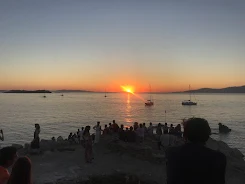Whilst travelling home and looking at a weather app, I noticed something I'd never considered before - that is, there are unique stages going from sunset to a completely black night sky. The collective term for these stages is twilight, and that's what this blogpost is about.
Obviously the length of twilight will vary at which point of the year you are at - during the summer, the days are longer in duration because the sunrise is earlier and the sunset is later, and the opposite is true during the winter. As well as this, nights are shortest during the summer and longest during the winter, which, combined with the fact that it gets darker much quicker in winter than it does during the summer, suggests that twilight is longest during the summer than it is during the winter. This came as a surprise to me, as I thought that it would be the other way around - that since the days are shorter in winter, that twilight would theoretically last a longer time as well. At the poles, twilight can even last an entire 24 hour period.
Yet its not that simple, and this is partially due to how high up the Sun is compared to where one is during the summer or during the winter. This blogpost by one of my favourite bloggers, Diamond Geezer, explains the idea of solar elevation well - but to put it simply, the sun is much higher up during the summer than it is during the winter. This has the side effect of the sun setting for longer during the summer than it does during the winter, so therefore twilight will last longer.
Once the sun has reached the horizon, its solar elevation relative to you is 0°, and will not be seen for many hours afterwards before it returns in the east the following day, the Earth having completed another half-orbit in that time relative to you. But that's obviously not so simple, because it doesn't go entirely dark instantly at dusk - and this is the twilight period, which is split up into three stages, all with interesting names - civil, nautical, and astronomical.
Civil twilight is such which occurs at an angle of 0° to 6° below the horizon, and as the Sun is still rather close, it will remain rather light outside. Think relatively blueish skies, maybe a reddish haze in the background, but nothing too dissimilar from before the sunset. Why it's called civil is possibly as it still allows you to not have to use a torch to see outside - indeed, the Merriam Webster dictionary mentions this in their definition of a civil twilight, suggesting that one reason why we separate twilight into separate categories is due to how well they allow us to function outside.
This makes the next stage, nautical twilight, perhaps easier to discern. It's when the sun is 6° to 12° below the horizon, at a time when the sky has become darker, but not so dark that you can't see the sea clearly - hence "nautical". Seemingly, sailors would be able to take readings from stars once nautical twilight began as the horizon was visible.
The final stage is astronomical twilight, which occurs once the sun is 12° to 18° below the horizon. Astronomers at this point can study stars much better, which is obviously easier if there's little to no light pollution. However, fainter structures such as galaxies require the sun to be further below the horizon, at which point night is considered to begin. Most though would consider this time as night anyways, and to get around you'd require streetlamps or the moon for lighting.
From here, the cycle begins anew - once the sun is 18° below the horizon once more, it's astronomical dusk, and followed by nautical and civil dusk, and then sunrise.
To conclude this blogpost, I thought I might include some photos of sunsets and twilight:




Fabulous
ReplyDelete